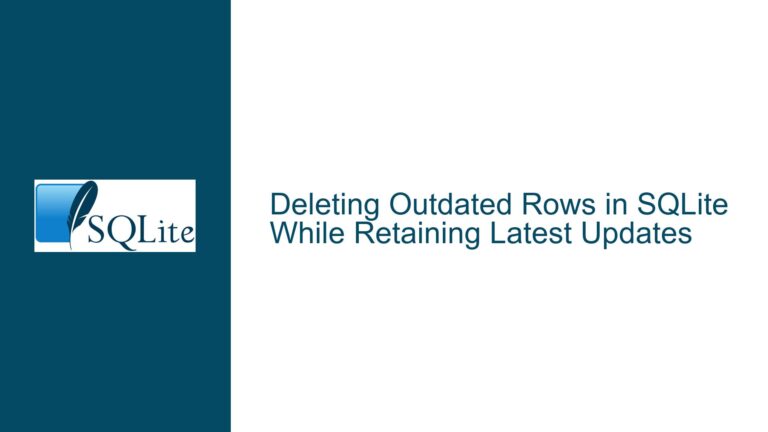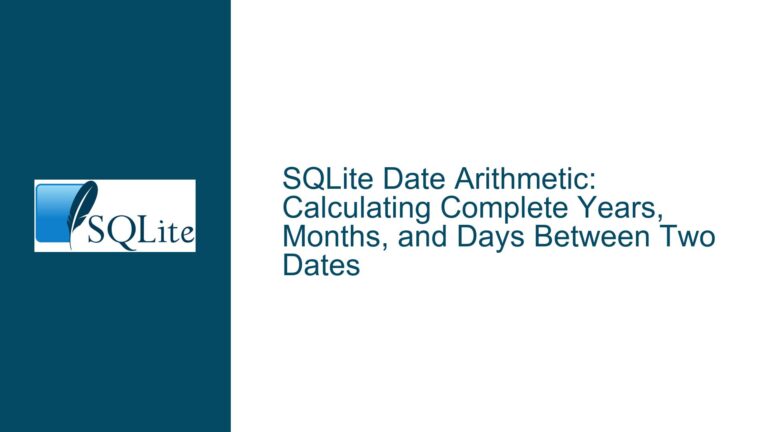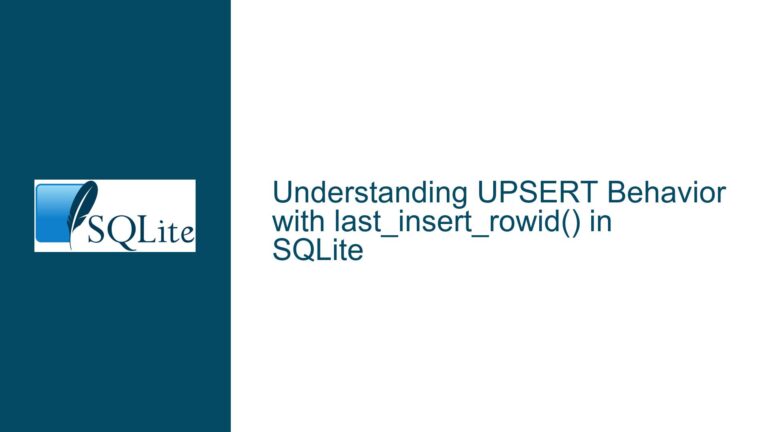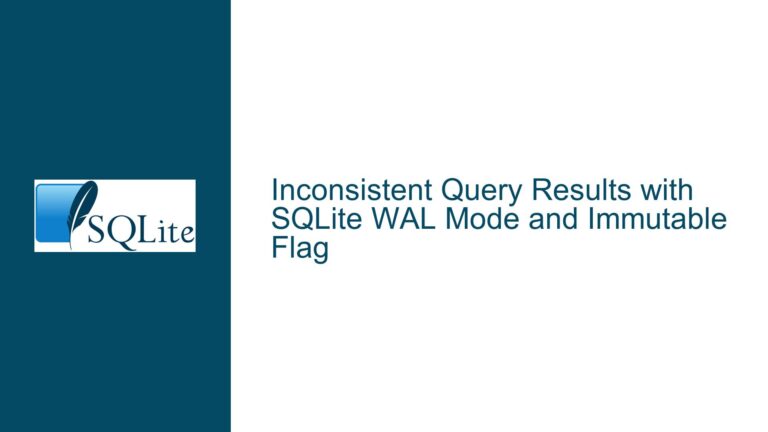Selecting Contiguous Sensor Data with Adjacent Rows in SQLite
Retrieving Sensor Data with Adjacent Rows for Continuous Charting
Issue Overview
The core issue revolves around retrieving sensor data from an SQLite database in a way that ensures continuity when visualizing the data in a chart. Sensor data is inserted into the database at irregular intervals, with each entry consisting of a datetime value and a corresponding numeric value. The challenge arises when attempting to display this data in a chart, particularly when there are only a few entries for a given day. The current approach of selecting data within a specific time range (e.g., a single day) results in a chart that appears discontinuous or "off" because it lacks the context of the data points immediately before and after the selected range.
The goal is to enhance the query to include not only the data within the specified time range but also the immediately preceding and succeeding rows. This would ensure that the chart displays a more continuous and accurate representation of the sensor data, even when the data points are sparse within the selected range.
Possible Causes
The discontinuity in the chart arises from the way the data is being queried. The current approach selects data strictly within a specified time range, such as a single day, without considering the adjacent data points that could provide context for the visualization. This is particularly problematic when the sensor data is sparse, as the chart may appear to have abrupt starts and stops, which do not accurately reflect the underlying data trends.
One potential cause of this issue is the assumption that the data within the selected time range is sufficient for visualization. However, in practice, the adjacent data points can provide valuable context, especially when the data is irregularly spaced. Another potential cause is the reliance on row IDs or other contiguous identifiers, which may not be reliable if deletions have occurred in the table. This can lead to incorrect results when attempting to retrieve adjacent rows based on row IDs.
Additionally, the issue may be exacerbated by the way the data is structured. If the table does not have a unique constraint on the datetime column, or if the datetime values are not stored in a format that allows for easy comparison, it can be challenging to accurately retrieve the adjacent rows. The use of suboptimal query structures, such as multiple separate queries combined with UNION, can also lead to performance issues and increased complexity.
Troubleshooting Steps, Solutions & Fixes
To address the issue of retrieving contiguous sensor data with adjacent rows, we need to consider several approaches that ensure the query is both accurate and efficient. The following steps outline the process of troubleshooting and resolving the issue:
Step 1: Understanding the Data Structure
Before attempting to modify the query, it is essential to understand the structure of the data. The table in question, logtable, contains two columns: logtime (a numeric value representing the datetime) and logdata (a text value containing the sensor data). The logtime column is unique, which means that each datetime value is associated with only one entry in the table. This uniqueness is crucial for accurately retrieving adjacent rows based on datetime values.
Step 2: Retrieving Data Within the Specified Time Range
The first part of the query involves selecting the data within the specified time range. This can be achieved using a simple SELECT statement with a WHERE clause that filters the data based on the logtime column. For example, to retrieve all entries for a specific day, the query would look like this:
SELECT * FROM logtable
WHERE logtime >= '2021-12-10 00:00:00' AND logtime < '2021-12-11 00:00:00';
This query will return all rows where the logtime falls within the specified day. However, as previously discussed, this approach does not include the adjacent rows that are necessary for a continuous chart.
Step 3: Retrieving the Immediately Preceding Row
To retrieve the row immediately before the specified time range, we can use a subquery that selects the maximum logtime value that is less than the start of the range. This can be achieved with the following query:
SELECT * FROM logtable
WHERE logtime = (SELECT MAX(logtime) FROM logtable WHERE logtime < '2021-12-10 00:00:00');
This query will return the row with the latest logtime value that is still before the start of the specified range. This row represents the immediately preceding data point and should be included in the final result set to ensure continuity in the chart.
Step 4: Retrieving the Immediately Succeeding Row
Similarly, to retrieve the row immediately after the specified time range, we can use a subquery that selects the minimum logtime value that is greater than or equal to the end of the range. The query would look like this:
SELECT * FROM logtable
WHERE logtime = (SELECT MIN(logtime) FROM logtable WHERE logtime >= '2021-12-11 00:00:00');
This query will return the row with the earliest logtime value that is still after the end of the specified range. This row represents the immediately succeeding data point and should also be included in the final result set.
Step 5: Combining the Results with UNION
Once we have the queries for retrieving the data within the specified range, the immediately preceding row, and the immediately succeeding row, we can combine these results using the UNION operator. The UNION operator allows us to combine the results of multiple SELECT statements into a single result set. The final query would look like this:
SELECT * FROM logtable
WHERE logtime >= '2021-12-10 00:00:00' AND logtime < '2021-12-11 00:00:00'
UNION
SELECT * FROM logtable
WHERE logtime = (SELECT MAX(logtime) FROM logtable WHERE logtime < '2021-12-10 00:00:00')
UNION
SELECT * FROM logtable
WHERE logtime = (SELECT MIN(logtime) FROM logtable WHERE logtime >= '2021-12-11 00:00:00')
ORDER BY logtime;
This query combines the results of the three SELECT statements and orders them by the logtime column, ensuring that the data is presented in chronological order. The inclusion of the adjacent rows ensures that the chart will display a continuous representation of the sensor data.
Step 6: Optimizing the Query for Performance
While the above query is functionally correct, it may not be the most efficient, especially when dealing with large datasets. To optimize the query, we can use Common Table Expressions (CTEs) to simplify the logic and improve readability. Additionally, we can use the WITH clause to define the subqueries for the adjacent rows, which can then be referenced in the main query. The optimized query would look like this:
WITH rangemin AS (
SELECT MAX(logtime) AS min_time FROM logtable WHERE logtime < '2021-12-10 00:00:00'
), rangemax AS (
SELECT MIN(logtime) AS max_time FROM logtable WHERE logtime >= '2021-12-11 00:00:00'
)
SELECT * FROM logtable
WHERE logtime >= '2021-12-10 00:00:00' AND logtime < '2021-12-11 00:00:00'
UNION
SELECT * FROM logtable WHERE logtime = (SELECT min_time FROM rangemin)
UNION
SELECT * FROM logtable WHERE logtime = (SELECT max_time FROM rangemax)
ORDER BY logtime;
This query uses CTEs to define the rangemin and rangemax subqueries, which are then referenced in the main query. This approach not only improves readability but also ensures that the subqueries are executed only once, which can lead to performance improvements.
Step 7: Handling Deletions and Non-Contiguous Row IDs
One potential issue with the above approach is that it relies on the assumption that the row IDs in the logtable are contiguous. However, if rows have been deleted from the table, the row IDs may no longer be contiguous, which could lead to incorrect results when attempting to retrieve adjacent rows based on row IDs.
To address this issue, we can modify the query to use the logtime column directly, rather than relying on row IDs. This approach ensures that the query will work correctly even if rows have been deleted from the table. The modified query would look like this:
WITH rangemin AS (
SELECT MAX(logtime) AS min_time FROM logtable WHERE logtime < '2021-12-10 00:00:00'
), rangemax AS (
SELECT MIN(logtime) AS max_time FROM logtable WHERE logtime >= '2021-12-11 00:00:00'
)
SELECT * FROM logtable
WHERE logtime >= '2021-12-10 00:00:00' AND logtime < '2021-12-11 00:00:00'
UNION
SELECT * FROM logtable WHERE logtime = (SELECT min_time FROM rangemin)
UNION
SELECT * FROM logtable WHERE logtime = (SELECT max_time FROM rangemax)
ORDER BY logtime;
This query uses the logtime column directly to retrieve the adjacent rows, ensuring that the results are accurate even if rows have been deleted from the table.
Step 8: Testing and Validation
After implementing the above query, it is essential to test and validate the results to ensure that the query is functioning as expected. This involves running the query against a sample dataset and verifying that the results include the data within the specified time range, as well as the immediately preceding and succeeding rows.
For example, using the sample data provided in the discussion:
CREATE TABLE logtable(
logtime NUMERIC NOT NULL UNIQUE,
logdata TEXT
);
INSERT INTO logtable(logtime, logdata) VALUES
('2021-12-09 15:00:00', 'This log is earlier on the previous day - Should be ignored'),
('2021-12-09 22:00:00', 'This log is later on the previous day - Should be ignored'),
('2021-12-09 23:00:00', 'This log is the last log on the previous day, report should start here'),
('2021-12-10 01:00:00', 'This log is the earliest on the report day - Include it'),
('2021-12-10 12:00:00', 'This log is the middle on the report day - Include it'),
('2021-12-10 22:00:00', 'This log is the latest on the report day - Include it'),
('2021-12-11 01:00:00', 'This log is the earliest on the day after, the report should end here'),
('2021-12-11 05:00:00', 'This log is another log on the day after - Should be ignored');
Running the optimized query against this dataset should return the following results:
logtime | logdata
------------------|------------------------------------------------------------------------
2021-12-09 23:00:00 | This log is the last log on the previous day, report should start here
2021-12-10 01:00:00 | This log is the earliest on the report day - Include it
2021-12-10 12:00:00 | This log is the middle on the report day - Include it
2021-12-10 22:00:00 | This log is the latest on the report day - Include it
2021-12-11 01:00:00 | This log is the earliest on the day after, the report should end here
These results include the data within the specified time range (2021-12-10), as well as the immediately preceding and succeeding rows, ensuring that the chart will display a continuous representation of the sensor data.
Step 9: Final Considerations and Best Practices
When implementing the above solution, it is important to consider the following best practices:
Indexing: Ensure that the
logtimecolumn is indexed to improve query performance, especially when dealing with large datasets. An index on thelogtimecolumn will allow the database to quickly locate the rows that fall within the specified time range, as well as the adjacent rows.Data Integrity: Ensure that the
logtimecolumn is unique and that the data is stored in a consistent format. This will prevent issues with duplicate or inconsistent datetime values, which could lead to incorrect results.Query Optimization: Regularly review and optimize the query to ensure that it performs well, especially as the dataset grows. This may involve using more advanced techniques, such as window functions or materialized views, depending on the specific requirements of the application.
Testing: Thoroughly test the query against a variety of datasets to ensure that it produces accurate results in all scenarios. This includes testing with sparse data, dense data, and datasets with deletions or other anomalies.
By following these best practices, you can ensure that the query is both accurate and efficient, providing a reliable solution for retrieving contiguous sensor data with adjacent rows in SQLite.
In conclusion, the issue of retrieving contiguous sensor data with adjacent rows in SQLite can be effectively addressed by combining the results of multiple SELECT statements using the UNION operator. By carefully structuring the query and considering potential issues such as non-contiguous row IDs and deletions, you can ensure that the chart displays a continuous and accurate representation of the sensor data. With proper indexing, data integrity, and query optimization, this approach can be scaled to handle large datasets and complex scenarios, providing a robust solution for visualizing sensor data in SQLite.






